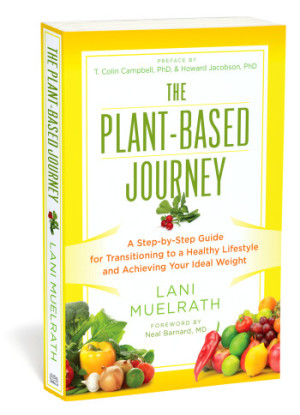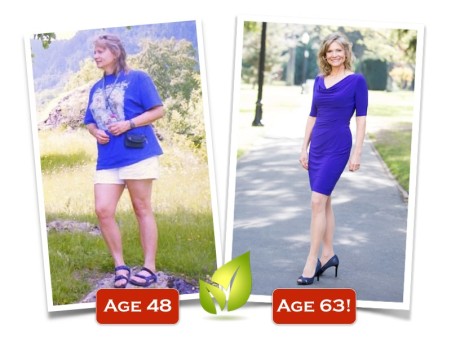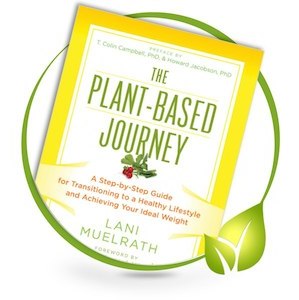
Have you been thinking about making changes to your diet and lifestyle? Maybe you want to take that leap from frumpy & tired to healthy & fit? Then The Plant-Based Journey is the perfect book for you!
Author, Lani Muelrath, has done a masterful job in creating what I’d like to refer to as the bible of ‘how to’ when it comes to making the successful journey from the Standard American Diet/Lifestyle to a whole foods, plant-based (WFPB) lifestyle. She’s even thrown in some ‘why’ in the beginning of this book to help you understand the powerful effects that plant-based nutrition and lifestyle medicine has on the human body.
6 Stages to Optimal Health
You’re journey towards optimal health starts with a 6-stage process as outlined by Lani in The Plant-Based Journey:
Stage 1 – Awakening – You’ll find your ‘why’ in your desire to adopt a healthy, plant-based lifestyle.
Stage 2 – Scout – You’ll learn the basics to what plant-based living is all about. What does your plate, shopping list, and kitchen look like?
Stage 3 – Rookie – Put what you’ve learned as a Scout to work as you spring into action living the first days of your plant-based journey.
Stage 4 – Rock Star – Continue to master your new plant-based lifestyle by learning and implementing tips for dining out, traveling, and making it through those challenging social situations. You’re 90% plant-based now!
Stage 5 – Champion – Go full on into a 100% plant-based diet with Lani’s Ten-Day Plant-Based Makeover.
Stage 6 – The Key Supporting Players: Exercise and Mastering Strength of Mind – Go beyond your dinner plate to learn how exercise and mastering the mental aspect of life’s challenges will help you succeed in the long-term.
The Plant-Based Journey Interview With Author Lani Muelrath
To help you get further insight into The Plant-Based Journey, I asked Lani a few important questions that came to mind while reading her book. I hope you find them both helpful and inspiring as you embark on your own plant-based journey.

Dustin: In Chapter 2 you detail parts of your personal story in your own plant-based journey. One of the primary reasons for adopting a plant-based diet was your quest to get healthy and lose weight. How much weight did you lose from your highest point?
Lani: Down 50 lbs from my highest weight, which I’ve maintained going on now for over 15 years. That’s important to point out, because sustainability with The Plant-Based Journey lifestyle is what has made the difference – I’d lost and gained weight multiple times before that. When the system came together for me – which I’ve detailed at length in Journey – that is what made the sustainable difference.
Dustin: You’re a seasoned veteran when it comes to exploring the world on a plant-based diet. One of my favorite moments while reading your book was when you recalled just turning vegetarian and taking off to Afghanistan with your newlywed husband, Greg, on a Peace Corp assignment. You mentioned how Afghanistan was one of the most difficult places in the world to find vegetarian meals given their meat-laden culture. Can you tell us, based on your global travels, which destination has been the easiest to find plant-based friendly meals in?
Lani: For restaurant eating, the winner has got to be Indonesia. This is the birthplace of tempeh and it’s one of the few places in the world where a restaurant doesn’t throw cream, butter or cheese into everything! The produce is beautiful and simply prepared – a lovely garlic bok choy served at breakfast comes to mind. Another good place as been on safari in Africa, where the lodges proudly serve a larger array of vegetarian and vegan foods than dishes with animal products. In most places, however, we rent a house so that I have my own kitchen for simple meals, for which we can shop in the marketplace. Italy and Mexico come to mind as primo places for getting great produce easily, along with other staples such as rice, beans, and breads in the market.
Dustin: The Plant-Based Journey is all about making your way from point A (Standard American Diet or SAD) to point B (whole foods, plant-based diet). When I talk to people about this for the first time, I often hear them say, “I could never eat like that because I could never give up my meat (or dairy, or eggs, or ice cream, or so forth).” I love your new approach to this whole thought process, where you state your goal is not to be perfect but rather “perfect enough.” What does that mean, and how can those interested in making the plant-based journey use this to their advantage?
Lani: This has been one of the most exciting things about how well Journey is being received, across the board – the inclusive nature of my approach. Human nature is such that we have several biases – including a loss-aversion bias – where we don’t want to let go of the cherished familiar. Understanding these points of resistance going in, we start to disarm the inner rebel – which is why I specifically address it in Journey. It’s important for people to know the risks of continuing to eat and live in an unhealthy fashion. But guilt and shame, the research shows us, are not the primary pathways to sustainable lifestyle change. Building on the positive is – and that is underscored by my decades of work in the classroom and as a coach, along with the survey results I report in Journey. And all of them deeply inform the manuscript of my book.
An example of perfect enough can be seen in something as simple as the decision a person might make to start eating more broccoli. Overwhelmed by information and wanting to get it ‘right’, they may feel prevailed upon to go out and find organic, local, seasonal fresh broccoli. Honestly, I’ve seen this happen. This can put too much pressure on the “plants in” process from the outset, when a bag of frozen broccoli from the market would have been, as I say, perfect enough.

Dustin: In Chapter 6 you talk about different ways to transition to a whole foods, plant-based diet—“get out of the fire”, one-at-a-time, and meal-by-meal methods. In your experience coaching others to eat healthier have you found that some individuals completely fail using one of these methods only to achieve success using another? If so, at what point does a person know when to try something different?
Lani: The “overnight” approach can be sustained by some, but only when prepared for. The 5 steps of transition as detailed in Journey are universal essentials for everyone who makes sustainable transition. Some people can go through these steps quickly: getting prepared kitchen, workplace, restaurant skills, family strategies – all of it that is necessary for changing your lifestyle in this most fundamental way. Yet often overnight doesn’t take as well as we’d hoped, requiring a little more preparation, which is all strategically and sequentially detailed in the five steps. When people fall short on an overnight attempt at change, I want to encourage them because it doesn’t mean they can’t do this thing! It simply means this is an opportunity to look at the 5 steps and see which may need a little more attention to create success. The discouragement and shame of failure is more of a block than the actually experience of not being “perfect”. It gives you important information about specific next steps. Debby Knight Jones, one of the Plant-Based Transformation studies (see page 172), is another example of someone who had a degree of success, spiraled into deep health challenges, and then came to me for assistance at moving forward to health again by implementing the steps and the support systems, which I also detail in Journey.
Dustin: I really enjoyed reading stories of families adopting a plant-based lifestyle in your book. This can be difficult, to say the least, with children in the household. Kids don’t always like healthy fare. In your own experience coaching families is any one certain method better than others for getting kids to come aboard the plant-based lifestyle depending on their age (toddler versus pre-teen versus adolescent)?
Lani: In all cases, we have to remember who is the adult here. Parents need to parent and are still in the position of making health care decisions for their children, and have control over plates in the house. This is where doing what you say is paramount. If parents don’t want their children indulging in junk food, then they can’t keep it in the cupboard and eat it at whim themselves. It can be far easier for everyone not to have it around – this came through clear in the case studies and modeled examples in Journey. Children also need to have a growing sense of autonomy, so including them in procuring good food, preparing it, and making it available – all examples illustrated in Journey – is important. Remember behavioral economics and provision of choice! (chapter 10 in Journey)
Dustin: I love how you provide plant-based recipe templates in your book for things like soups, burgers, and sandwiches. Instead of following exact recipes you teach people general guidelines to make various versions of these meals. This is exactly how I prepare and cook most of my food too! Do you find that the average SAD dieter takes to this approach easily when first starting out?
Lani: Yes! This has been a surprise hit feature of The Plant-Based Journey, though my publisher identified the Recipe Templates as a unique starring feature of the book. Along with the philosophy and tone of Journey, it has had the effect of bringing accessibility, inclusion, and simplicity to the transition. That along with the “plantifying your plate” sections, which CBS TV asked me to do a segment on last week.
Dustin: If you could give just one piece of advice to someone wanting to achieve success in making healthy into a lifestyle and not just an afterthought, what would that piece of advice be?
Lani: First, establish a strong connection to your reasons for changing what’s on your plate, as it all starts in your mind and heart. Right along with that, realize the importance of developing some degree of mastery over your thinking practices – a muscle that can be shaped and strengthened like any other. This is essential for changing something as fundamental as what you eat. This is why it is one of the key supporting players, right along with physical activity. It underscores and threads through and gives life to every one of the 5 steps.
And enjoy what you eat!
Summary and Book Contest Giveaway Details
The Plant-Based Journey is an invaluable resource for anyone looking to turn their life around for the better, embracing a health-centered diet and lifestyle to make this happen. Don’t miss out on Lani’s new book now available on Amazon and other retailers found on her website here. You won’t regret it!
To celebrate the release of Lani’s new book, I’m holding a special giveaway contest below. Make sure and enter below to secure your chance at winning your very own copy of The Plant-Based Journey!

If you like what you see here, then you’ll LOVE my daily Facebook and Twitter posts! Also, don’t forget to sign up for my Free Online Mailing List to get all the latest updates from the Plant-Based Pharmacist!
Check out my book, The Empty Medicine Cabinet, to start your journey towards better health. This step-by-step guide leads you through many of today’s common chronic diseases (heart disease, obesity, diabetes, cancer, and more), giving you the facts on food versus medication in treating these medical conditions. The book also contains an easy-to-follow guide on how to adopt a whole foods, plant-based diet as a part of an overall lifestyle change, producing the best possible health outcomes for you and your family. Hurry and get your copy today!


.jpg)
Not planning ahead then finding myself very hungry and willing to grab anything instead of making sure it was a healthy choice.
The biggest hurdle has been acceptance and/or ridicule from friends, family and acquaintances. Some very dear friends have distanced themselves from us since adopting this lifestyle. To this day, people still ask my husband “when your wife’s not around you have a steak right?”
I’m struggling with my friends / family. I haven’t officially “come out” as WFPB, but I know I will face lots of ridicule / questioning when I do 🙁
I haven’t officially come out as “WFPB” to my friends / family yet, but I know they will question me lots when I do. 🙁
When it came to preparing food I couldn’t be lazy any more
Looks like an awesome tool 🙂
I sometimes struggle with quick & easy fall back food that isn’t pasta all the time!
It would be helpful for many to have available more information on mental health and healing from mental illnesses with a compassion vegan type diet. I am sure that the kindness factor would help, as harmless to others is a sign of psychological health.